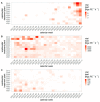Expanding the Pathogen Panel in Wastewater Epidemiology to Influenza and Norovirus
- PMID: 36851479
- PMCID: PMC9966704
- DOI: 10.3390/v15020263
Expanding the Pathogen Panel in Wastewater Epidemiology to Influenza and Norovirus
Abstract
Since the start of the 2019 pandemic, wastewater-based epidemiology (WBE) has proven to be a valuable tool for monitoring the prevalence of SARS-CoV-2. With methods and infrastructure being settled, it is time to expand the potential of this tool to a wider range of pathogens. We used over 500 archived RNA extracts from a WBE program for SARS-CoV-2 surveillance to monitor wastewater from 11 treatment plants for the presence of influenza and norovirus twice a week during the winter season of 2021/2022. Extracts were analyzed via digital PCR for influenza A, influenza B, norovirus GI, and norovirus GII. Resulting viral loads were normalized on the basis of NH4-N. Our results show a good applicability of ammonia-normalization to compare different wastewater treatment plants. Extracts originally prepared for SARS-CoV-2 surveillance contained sufficient genomic material to monitor influenza A, norovirus GI, and GII. Viral loads of influenza A and norovirus GII in wastewater correlated with numbers from infected inpatients. Further, SARS-CoV-2 related non-pharmaceutical interventions affected subsequent changes in viral loads of both pathogens. In conclusion, the expansion of existing WBE surveillance programs to include additional pathogens besides SARS-CoV-2 offers a valuable and cost-efficient possibility to gain public health information.
Keywords: PEG-precipitation; digital PCR; influenza; inpatients; norovirus; surveillance; wastewater; wastewater-based epidemiology.
Conflict of interest statement
The authors declare that the research was conducted in the absence of any commercial or financial relationships that could be construed as a potential conflict of interest.
Figures




Similar articles
-
Beyond COVID-19: Wastewater-based epidemiology for multipathogen surveillance and normalization strategies.Sci Total Environ. 2024 Oct 10;946:174419. doi: 10.1016/j.scitotenv.2024.174419. Epub 2024 Jul 2. Sci Total Environ. 2024. PMID: 38960169
-
Optimization of the 5-plex digital PCR workflow for simultaneous monitoring of SARS-CoV-2 and other pathogenic viruses in wastewater.Sci Total Environ. 2024 Feb 25;913:169746. doi: 10.1016/j.scitotenv.2023.169746. Epub 2023 Dec 28. Sci Total Environ. 2024. PMID: 38159741
-
Piloting wastewater-based surveillance of norovirus in England.Water Res. 2024 Oct 1;263:122152. doi: 10.1016/j.watres.2024.122152. Epub 2024 Jul 29. Water Res. 2024. PMID: 39096810
-
Wastewater-based epidemiology (WBE) for SARS-CoV-2 - A review focussing on the significance of the sewer network using a Dublin city catchment case study.Water Sci Technol. 2022 Sep;86(6):1402-1425. doi: 10.2166/wst.2022.278. Water Sci Technol. 2022. PMID: 36178814 Review.
-
How has the COVID-19 pandemic impacted wastewater-based epidemiology?Sci Total Environ. 2023 Sep 20;892:164561. doi: 10.1016/j.scitotenv.2023.164561. Epub 2023 May 30. Sci Total Environ. 2023. PMID: 37263440 Free PMC article. Review.
Cited by
-
Tracking epidemic viruses in wastewaters.Microb Biotechnol. 2024 Oct;17(10):e70020. doi: 10.1111/1751-7915.70020. Microb Biotechnol. 2024. PMID: 39382399 Free PMC article. Review.
-
Long Amplicon Nanopore Sequencing for Dual-Typing RdRp and VP1 Genes of Norovirus Genogroups I and II in Wastewater.Food Environ Virol. 2024 Dec;16(4):479-491. doi: 10.1007/s12560-024-09611-5. Epub 2024 Sep 6. Food Environ Virol. 2024. PMID: 39240456 Free PMC article.
-
Detection of influenza virus in urban wastewater during the season 2022/2023 in Sicily, Italy.Front Public Health. 2024 Jul 23;12:1383536. doi: 10.3389/fpubh.2024.1383536. eCollection 2024. Front Public Health. 2024. PMID: 39109154 Free PMC article.
-
Simultaneous detection of influenza A, B and respiratory syncytial virus in wastewater samples by one-step multiplex RT-ddPCR assay.Hum Genomics. 2024 May 20;18(1):48. doi: 10.1186/s40246-024-00614-8. Hum Genomics. 2024. PMID: 38769549 Free PMC article.
-
Estimating actual SARS-CoV-2 infections from secondary data.Sci Rep. 2024 Mar 20;14(1):6732. doi: 10.1038/s41598-024-57238-0. Sci Rep. 2024. PMID: 38509181 Free PMC article.
References
-
- Ahmed W., Angel N., Edson J., Bibby K., Bivins A., O’Brien J.W., Choi P.M., Kitajima M., Simpson S.L., Li J., et al. First confirmed detection of SARS-CoV-2 in untreated wastewater in Australia: A proof of concept for the wastewater surveillance of COVID-19 in the community. Sci. Total Environ. 2020;728:138764. doi: 10.1016/j.scitotenv.2020.138764. - DOI - PMC - PubMed
-
- Medema G., Heijnen L., Elsinga G., Italiaander R., Brouwer A. Presence of SARS-Coronavirus-2 RNA in Sewage and Correlation with Reported COVID-19 Prevalence in the Early Stage of the Epidemic in The Netherlands. Environ. Sci. Technol. Lett. 2020;7:511–516. doi: 10.1021/acs.estlett.0c00357. - DOI - PubMed
-
- Markt R., Endler L., Amman F., Schedl A., Penz T., Büchel-Marxer M., Grünbacher D., Mayr M., Peer E., Pedrazzini M., et al. Detection and abundance of SARS-CoV-2 in wastewater in Liechtenstein, and the estimation of prevalence and impact of the B.1.1.7 variant. J. Water Health. 2022;20:114–125. doi: 10.2166/wh.2021.180. - DOI - PubMed
-
- Graham K.E., Loeb S.K., Wolfe M.K., Catoe D., Sinnott-Armstrong N., Kim S., Yamahara K.M., Sassoubre L.M., Mendoza Grijalva L.M., Roldan-Hernandez L., et al. SARS-CoV-2 RNA in Wastewater Settled Solids Is Associated with COVID-19 Cases in a Large Urban Sewershed. Environ. Sci. Technol. 2021;55:488–498. doi: 10.1021/acs.est.0c06191. - DOI - PubMed
Publication types
MeSH terms
Substances
Grants and funding
LinkOut - more resources
Full Text Sources
Medical
Miscellaneous

